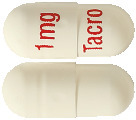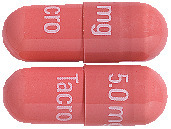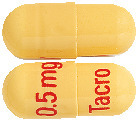SUMMARY CMI
PHARMACOR TACROLIMUS CAPSULES
Consumer Medicine Information (CMI) summary
The full CMI on the next page has more details. If you are worried about using this medicine, speak to your doctor or pharmacist.
1. Why am I using PHARMACOR TACROLIMUS?
PHARMACOR TACROLIMUS contains the active ingredient tacrolimus.
PHARMACOR TACROLIMUS is used so that your new liver, kidney, lung or heart will not be attacked or rejected by your body. For more information, see Section 1. Why am I using PHARMACOR TACROLIMUS? in the full CMI.
2. What should I know before I use PHARMACOR TACROLIMUS?
Do not use if you have ever had an allergic reaction to PHARMACOR TACROLIMUS, macrolide antibiotics, or any of the ingredients listed at the end of the CMI.
Talk to your doctor if you have any other medical conditions, take any other medicines, or are pregnant or plan to become pregnant or are breastfeeding.
For more information, see Section 2. What should I know before I use PHARMACOR TACROLIMUS? in the full CMI.
3. What if I am taking other medicines?
Some medicines may interfere with PHARMACOR TACROLIMUS and affect how it works.
Tell your doctor or pharmacist if you are taking any other medicines, including any medicines, vitamins or supplements that you buy without a prescription from your pharmacy, supermarket or health food shop.
See Section 3. What if I am taking other medicines? in the full CMI for information.
4. How do I use PHARMACOR TACROLIMUS?
- PHARMACOR TACROLIMUS capsules should be taken in two doses (e.g. morning and evening) each day.
- PHARMACOR TACROLIMUS capsules should be taken at least 1 hour before or 2 to 3 hours after a meal preferably with water and not with grapefruit juice.
- More instructions can be found in Section 4. How do I use PHARMACOR TACROLIMUS? in the full CMI.
5. What should I know while using PHARMACOR TACROLIMUS?
| Things you should do |
|
| Things you should not do |
|
| Driving or using machines |
|
| Looking after your medicine |
|
For more information, see Section 5. What should I know while using PHARMACOR TACROLIMUS? in the full CMI.
6. Are there any side effects?
There are a number of side effects associated with this medicine. It is important to be aware of them so that you can identify any symptoms if they occur (see the full CMI for more details). The serious side effects are: signs of allergy; fever; diabetes / increased blood sugar; swelling, numbness or tingling in your hands and feet; constant "flu-like" symptoms; unusual bleeding or bruising; high blood pressure; palpitations, abnormal heart rhythms, chest pain; new lumps or moles, or changes to existing moles; swelling of the eyelids, hands or feet due to excess fluid; a change in the amount of urine passed or in the number of times you urinate, pain on urinating, or other kidney problems; yellowing of the skin and/or eyes (jaundice); symptoms of anaemia; seizures (fits); buzzing or ringing in the ears, difficulty hearing.
For more information, including what to do if you have any side effects, see Section 6. Are there any side effects? in the full CMI.
FULL CMI
PHARMACOR TACROLIMUS CAPSULES
Active ingredient(s): tacrolimus monohydrate
Consumer Medicine Information (CMI)
This leaflet provides important information about using PHARMACOR TACROLIMUS capsules. It does not contain all the available information. It does not take the place of talking to your doctor or pharmacist.
All medicines have risks and benefits. Your doctor has weighed the risks of you taking PHARMACOR TACROLIMUS against the benefits this medicine is expected to have for you.
You should also speak to your doctor or pharmacist if you would like further information or if you have any concerns or questions about PHARMACOR TACROLIMUS.
Keep this leaflet with your medicine. You may need to read it again.
Where to find information in this leaflet:
1. Why am I using PHARMACOR TACROLIMUS?
2. What should I know before I use PHARMACOR TACROLIMUS?
3. What if I am taking other medicines?
4. How do I use PHARMACOR TACROLIMUS?
5. What should I know while using PHARMACOR TACROLIMUS?
6. Are there any side effects?
7. Product details
1. Why am I using PHARMACOR TACROLIMUS?
PHARMACOR TACROLIMUS contains the active ingredient tacrolimus, which is an immunosuppressive agent.
You have been given a new transplanted liver, kidney, lung or heart from another person because your own was no longer healthy. Your body recognises that this new organ is different from your other organs and will try to reject it by attacking it in the same way that it would attack germs that enter your body. This could make you become ill again. PHARMACOR TACROLIMUS stops this attack; it is very important to take PHARMACOR TACROLIMUS given to you by your doctor regularly so that your new liver, kidney, lung or heart will not be attacked or rejected.
If you have been taking other medicines for this purpose, but are still feeling unwell, your doctor may change your treatment and begin giving you PHARMACOR TACROLIMUS.
Your doctor may have prescribed PHARMACOR TACROLIMUS for another reason.
Ask your doctor if you have any questions about why this medicine has been prescribed for you.
2. What should I know before I use PHARMACOR TACROLIMUS?
Warnings
Do not use PHARMACOR TACROLIMUS if:
- you are allergic to any medicine containing tacrolimus or other macrolides (these are antibiotics of the erythromycin family - trade names are Eryc, EES, Klacid, Zithromax, Rulide and Biaxsig), or any of the ingredients listed at the end of this leaflet.
- Always check the ingredients to make sure you can use this medicine.
Some of the symptoms of an allergic reaction may include:
- shortness of breath
- wheezing or difficulty breathing
- swelling of the face, lips, tongue or other parts of the body
- rash, itching or hives on the skin
Do not use PHARMACOR TACROLIMUS if the packaging is torn or shows signs of tampering. Do not use PHARMACOR TACROLIMUS beyond the expiry date printed on the pack.
Check with your doctor if:
- you are receiving cyclosporin immunosuppressive therapy.
If you have not told your doctor or pharmacist about any of the above, tell them before you start taking or are given PHARMACOR TACROLIMUS.
Your doctor will advise you whether or not to PHARMACOR TACROLIMUS or if you need to adjust the dose or adapt your treatment.
During treatment, you may be at risk of developing certain side effects. It is important you understand these risks and how to monitor for them. See additional information under Section 6. Are there any side effects?
Pregnancy and breastfeeding
Check with your doctor if you are pregnant or intend to become pregnant.
Talk to your doctor if you are breastfeeding or intend to breastfeed.
Check with your doctor if you are using oral contraceptives.
3. What if I am taking other medicines?
Tell your doctor or pharmacist if you are taking any other medicines, including any medicines, vitamins or supplements that you buy without a prescription from your pharmacy, supermarket or health food shop.
Some medicines may interfere with PHARMACOR TACROLIMUS and affect how it works.
In particular, you should tell your doctor if you are taking or have recently taken medicines like:
- antifungal medicines and antibiotics, particularly socalled macrolide antibiotics, used to treat infections e.g., ketoconazole, fluconazole, itraconazole, voriconazole, clotrimazole, miconazole, caspofungin, erythromycin, clarithromycin, josamycin, rifampicin, rifabutin and isoniazid
- letermovir, used to prevent illness caused by CMV (human cytomegalovirus)
- HIV protease inhibitors (e.g., ritonavir, nelfinavir, saquinavir), the booster medicine cobicistat, and combination tablets, or HIV non-nucleoside reverse transcriptase inhibitors (efavirenz, etravirine, nevirapine) used to treat HIV infection
- HCV protease inhibitors (e.g., telaprevir, boceprevir, the combination ombitasvir/paritaprevir/ritonavir with or without dasabuvir, elbasvir/grazoprevir, and glecaprevir/pibrentasvir), used to treat hepatitis C infection
- mycophenolic acid used to suppress the immune system to prevent transplant rejection
- medicines for stomach ulcer and acid reflux (e.g., omeprazole, lansoprazole or cimetidine)
- antiemetics, used to treat nausea and vomiting (e.g., metoclopramide)
- cisapride or the antacid magnesium-aluminium-hydroxide, used to treat heartburn
- the contraceptive pill or other hormone treatments with ethinylestradiol, hormone treatments with danazol
- medicines used to treat high blood pressure or heart problems (e.g., nifedipine, nicardipine, diltiazem and verapamil)
- anti-arrhythmic drugs (amiodarone) used to control arrhythmia (uneven beating of the heart)
- medicines known as “statins” used to treat elevated cholesterol and triglycerides
- carbamazepine, phenytoin or phenobarbital, used to treat epilepsy
- metamizole, used to treat pain and fever
- the corticosteroids prednisolone and methylprednisolone, belonging to the class of corticosteroids used to treat inflammations or suppress the immune system (e.g., in transplant rejection)
- nefazodone, used to treat depression
- herbal preparations containing St. John's wort (Hypericum perforatum) or extracts of Schisandra sphenanthera.
Tell your doctor if you are taking or need to take ibuprofen, amphotericin B, antibiotics (cotrimoxazole, vancomycin, or so-called aminoglycoside antibiotics such as gentamicin), or antivirals (e.g., acyclovir, ganciclovir, cidofovir, or foscarnet). These may worsen kidney or nervous system problems when taken together with PHARMACOR TACROLIMUS.
Your doctor also needs to know if you are taking potassium supplements or potassium-sparing diuretics (e.g., amiloride, triamterene, or spironolactone), or the antibiotics trimethoprim or cotrimoxazole that may increase levels of potassium in your blood, certain pain killers (so-called NSAIDs, e.g., ibuprofen), anticoagulants, or oral medication for diabetic treatment, while you receive PHARMACOR TACROLIMUS.
Your doctor or pharmacist can tell you what to do if you are taking any of these medicines.
4. How do I use PHARMACOR TACROLIMUS?
How much to take
- You can only get PHARMACOR TACROLIMUS from your doctor. Your dose will be calculated according to your weight, age, and medical condition. As your health and the function of your new liver, kidney, lung or heart can be affected by how much medicine you take, it is normal that your doctor tests samples of your blood and urine at regular intervals. This is in order to test whether your medicine requires adjustment.
When to take PHARMACOR TACROLIMUS
- PHARMACOR TACROLIMUS should be taken in two doses (e.g. morning and evening) each day.
How to take PHARMACOR TACROLIMUS?
- Take the capsule from the blister pack and swallow it whole with plenty of water. Do not use grapefruit juice as it contains substances that interfere with the action of PHARMACOR TACROLIMUS.
- PHARMACOR TACROLIMUS capsules should generally be taken on an empty stomach or at least 1 hour before or 2 to 3 hours after a meal.
- You must never change the dose yourself even if you are feeling better. It is very important that you keep taking this medicine so that your body will not reject your new liver, kidney, lung or heart.
- If you accidentally take a larger dose than recommended, tell your doctor immediately.
- If you do not understand the instructions provided with this medicine, ask your doctor or pharmacist for help.
If you forget to use PHARMACOR TACROLIMUS
If it is almost time for your next dose, skip the dose you missed and take your next dose when you are meant to.
Do not take a double dose to make up for the dose you missed.
If you have missed more than one dose, or are not sure what to do, check with your doctor or pharmacist.
If you have trouble remembering when to take your medicine, ask your pharmacist for some hints.
If you use too much PHARMACOR TACROLIMUS
If you think that you have used too much PHARMACOR TACROLIMUS, you may need urgent medical attention.
You should immediately:
- contact your doctor, or
- go to the Emergency Department at your nearest hospital. or
- phone the Poisons Information Centre (by calling 13 11 26),
You should do this even if there are no signs of discomfort or poisoning. You may need urgent medical attention.
5. What should I know while using PHARMACOR TACROLIMUS?
Things you should do
- Always follow your doctor's instructions carefully.
- Tell your doctor if you become pregnant while taking PHARMACOR TACROLIMUS.
- If you are about to start taking a new medicine, tell your doctor and pharmacist that you are taking PHARMACOR TACROLIMUS.
- PHARMACOR TACROLIMUS suppresses your immune system by lowering your body's immune defence system. This increases your risk of skin cancer and other cancers while taking PHARMACOR TACROLIMUS. You should always protect yourself from the sun, wear sunscreen, a hat and protective clothing.
Things you should not do
- Do not take PHARMACOR TACROLIMUS to treat any other complaint unless your doctor says so.
- Do not give this medicine to anyone else, even if their symptoms are similar to yours.
Driving or using machines
Be careful before you drive or use any machines or tools until you know how PHARMACOR TACROLIMUS affects you.
PHARMACOR TACROLIMUS may cause visual or nervous disturbances. If affected, do not drive or operate machinery.
Effects of food and alcohol
Food reduces the absorption of PHARMACOR TACROLIMUS. Therefore, the capsules should be taken at least 1 hour before or 2 to 3 hours after a meal.
Drinking alcohol
Tell your doctor if you drink alcohol.
Looking after your medicine
Use all the PHARMACOR TACROLIMUS capsules within 12 months of opening the aluminium wrapper.
Keep PHARMACOR TACROLIMUS capsules in the blisters until it is time to take them.
Keep PHARMACOR TACROLIMUS capsules in a cool dry place where the temperature is below 25°C.
Keep your medicines where children cannot reach them. A locked cupboard at least one-and-a-half metres (1.5 m) above the ground is a good place to store medicines.
Do not store PHARMACOR TACROLIMUS, or any other medicine, in the bathroom or near a sink. Do not leave medicines in the car or on window sills. Heat and dampness can destroy some medicines.
Keep it where young children cannot reach it.
When to discard your medicine
Getting rid of any unwanted medicine
If you no longer need to use this medicine or it is out of date, take it to any pharmacy for safe disposal.
Do not use this medicine after the expiry date.
6. Are there any side effects?
All medicines can have side effects. If you do experience any side effects, most of them are minor and temporary. However, some side effects may need medical attention.
See the information below and, if you need to, ask your doctor or pharmacist if you have any further questions about side effects.
Do not be alarmed by this list of possible side effects. You may not experience any of them.
Ask your doctor or pharmacist to answer any questions you may have.
Less serious side effects
| Less serious side effects | What to do |
| Speak to your doctor if you have any of these less serious side effects and they worry you. |
| Serious side effects | What to do |
| Call your doctor straight away, or go straight to the Emergency Department at your nearest hospital if you notice any of these serious side effects. |
Tell your doctor or pharmacist if you notice anything else that may be making you feel unwell.
Other side effects not listed here may occur in some people.
Reporting side effects
After you have received medical advice for any side effects you experience, you can report side effects to the Therapeutic Goods Administration online at www.tga.gov.au/reporting-problems. By reporting side effects, you can help provide more information on the safety of this medicine.
Always make sure you speak to your doctor or pharmacist before you decide to stop taking any of your medicines.
7. Product details
This medicine is only available with a doctor's prescription.
What PHARMACOR TACROLIMUS contains
| Active ingredient (main ingredient) | tacrolimus |
| Other ingredients (inactive ingredients) | PHARMACOR TACROLIMUS capsules contain Hypromellose, croscarmellose sodium, lactose, magnesium stearate, gelatin, water, sodium lauryl sulfate, titanium dioxide, colorants: iron oxide yellow for 0.5 mg capsules and iron oxide red for 5 mg capsules and printing ink: 0.5 mg and 1 mg capsules contains shellac and iron oxide red, 5 mg capsule contain shellac, potassium hydroxide and titanium dioxide. |
Do not take this medicine if you are allergic to any of these ingredients.
What PHARMACOR TACROLIMUS looks like
- PHARMACOR TACROLIMUS capsules 0.5 mg are yellow, packed in blister sheets of ten capsules and sealed in an aluminium wrapper (Pack size 100 capsules).
- PHARMACOR TACROLIMUS 1 mg capsules are white, packed in blister sheets of ten capsules and sealed in an aluminium wrapper (Pack size 100 capsules).
- PHARMACOR TACROLIMUS 5 mg capsules are greyish-red, packed in blister sheets of ten capsules and sealed in an aluminium wrapper (Pack size 50 capsules).
Who distributes PHARMACOR TACROLIMUS
Pharmacor Pty Ltd.
Suite 803, Level 8,
Tower A, The Zenith,
821 Pacific Highway,
Chatswood, NSW 2067,
Australia
www.pharmacor.com.au
Australian Registration Numbers:
PHARMACOR TACROLIMUS capsules 0.5 mg:
Blister Pack: 209272
PHARMACOR TACROLIMUS capsules 1 mg:
Blister Pack: 209266
PHARMACOR TACROLIMUS capsules 5 mg:
Blister Pack: 209267
This leaflet was prepared in 05/2023
Published by MIMS July 2023




 Molecular formula: C44H69NO12.H2O.
Molecular formula: C44H69NO12.H2O.